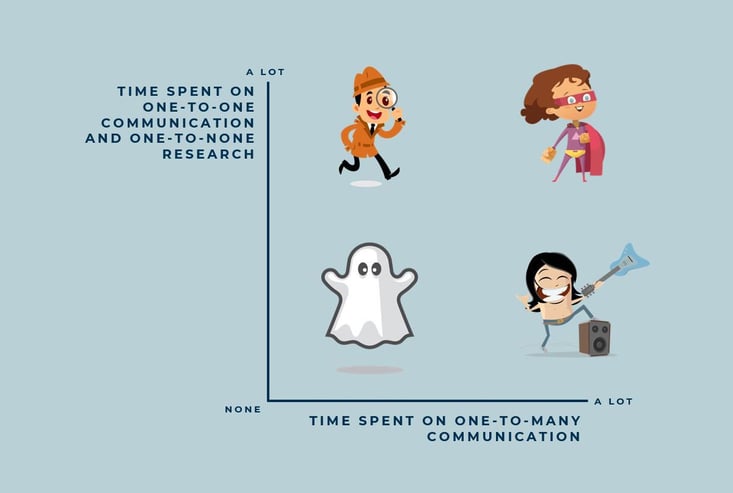
Today we will discuss 4 personas that can give you a good understanding of how to work with LinkedIn as a platform for communication and sales. So, are you a Ghost, Detective, Rockstar or Superhero? Do you prefer to listen instead of reading? Then join our webinar on the same topic here!
Books, articles and videos all praise the variety of functions and features available within the subject of social selling, but they all push the idea of one path to success. This article will present an alternative way of looking at social selling where different forms of super-users are shown, each with its unique way of attracting and converting strangers into clients through LinkedIn.
Consider the graph below. On the X-axis is a user’s drive to use LinkedIn to communicate with a broad group of people and on the Y-axis, a user’s drive to use LinkedIn for one-to-one-dialogue and research. Note that you can have a drive to do both, which is why doing one doesn’t take away from the other.
Here, the problem with most literature on social selling shows; too often it explains that you need to be a Rockstar super-user to be successful at social selling. This means that leads are generated by being active, writing articles, posts, comments on thoughtful subjects, providing great insights to the masses.
This is certainly a viable path, but a difficult one for those that don’t have the time needed to generate content based on credible insights or for those without a marketing department.
The idealization of the Rockstar is also, I believe, a reason for why so few people attempt to be successful at social selling. A lot of people see highly active thought leaders on LinkedIn and think they need to become one of them to gain any results. The gap they identify becomes so big they choose to not be active on LinkedIn at all!
With that said, let’s take a look a bit closer at each of the 4 LinkedIn personalities identified in the graph above.
1. THE GHOST
The Ghost is the persona most LinkedIn users will be forced to liken themselves to, even among those in a sales position. Some users within this group will be quite active, logging in daily to read and like others’ posts, looking up people they are due to meet with, sometimes even writing posts themselves. Others will barely have a profile page set up.
At this level there is nothing resembling a plan or strategy with the Ghost’s LinkedIn usage and the time spent there can be seen more as stress relief or leisure than anything else.
Often, they understand there is potential to do more, and get more out of the platform but they feel they don’t have the time or resources to work on it. It’s always planned for next month, next quarter, next year... when things calm down.
Advice on this level:
- Understand it’s okay to stay here, you can succeed in sales without social selling. In 5 years it may be different...
- Work on making the platform more fun to engage with, go through settings to learn what you can modify and learn to block news from people you want to stay connected with but who take over your LinkedIn feed.
- Learn about hashtags and groups to follow – it’s a fast track to the content you are interested in.
- Make sure your profile is visible to anyone. Even if you're not very active yourself, others (prospects) might be.
- Connect with people you interact with and who match (or almost match) your buyer persona. You never know when you want to become active and when you do, a good network is key.
Also, AVOID a bad profile picture! It’s like seeing a webpage for a company without an update in the last 10 years and it leaves a bad impression.
Be sure avoid the following:
- Full/half body shots – this will make it difficult to see your face in the already small area where your profile picture is visible.
- Low resolution pictures – it screams that you don’t understand computers.
- Sunglasses – this can look unprofessional.
- Private pictures – it’s not Facebook!
2. THE ROCKSTAR
The Rockstar is who we have in mind when we think about what social selling success looks like. These people have the magic ability to always find interesting news and insights to share with the world through articles, posts and comments that fill up yours, and everyone else’s LinkedIn feed.
And while there are other ways to succeed on LinkedIn, its right to hold these people in high regard because the below formula does in fact ensure a continuous stream of leads through social media:
- Create insightful and engaging content matching the buyer’s journey of your defined buyer personas.
- Respond to comments and connect with people.
- Thank them for their engagement and continue the dialogue through messenger.
- If relevant ask them for a call or meeting. Alternatively note what subject they had an interest in and write back to them when you have created new content you think is of interest to them - the fact you remembered and thought to reach out specifically to them will be appreciated. Once again ask to connect or repeat this step for long-term lead nurturing on social media.
AVOID just sharing others content without bringing any reason for doing so. Just regurgitating others content, or your company’s, will quickly turn you from being a Rockstar to a cover band!
So how do you – as a busy B2B tech-seller with days full of meetings, gruesome RFP processes, implementation periods, POCs, quotes etc. – find the time to create relevant and engaging content?
There are a few things to keep in mind:
- Use the research you already do each week. Hopefully you try to keep up to date within your area of business, right? Use that time for news updates and research to find material for your next article or post on LinkedIn. A bonus is that explaining something to others means you remember it better yourself.
- Reuse content in different ways. The article you spend hours writing can easily be split into several different blog posts, all directing your readers to the full article if they want to learn more. Or recreate the post you did into a video briefly explaining the same thing - different audiences will want to consume content in different ways.
- Remember the buyers’ journey. This topic could be an article on its own but to describe it briefly, every buyer of every product or service goes through a process before each purchase they make. Awareness (why do I have this problem?), consideration (how do I solve this problem?) and decision (who can help me with this problem?). The theory of inbound marketing and inbound sales is to build a relationship with a buyer from the very first step of their buyer’s journey. By doing that you have the potential of shaping their idea of what they ultimately should buy and thus the likelihood they’ll buy from you. If we apply this to social selling, it means that you should strive to create content that appeals to those in an early buying stage of the solutions you and your company provide. This is one of the most common mistakes I see on LinkedIn, people only posting what could be considered late stage content – decision stage. Very few people in your network will be at this stage and those who do will probably have had their purchasing priorities shaped by someone else who was there from an early stage.
- Don’t forget to encourage dialogue and discussion – as you remember from the formula above, that’s what proceeds the 1 to 1 dialogue that leads to sales meetings. Always include a good call to action and find the right balance - avoid open questions (what do you think sales is about?) and those that are too closed (is sales about selling yes or no?).
- Don’t create content just for your LinkedIn feed. Spend some time thinking about those in your network that really would appreciate your piece of content. Again only a few people in your network will actually see your new content in their feed, so send it directly to them! Also, think outside LinkedIn – E-mail it to people, put it on your company’s content page, shout it from the mountaintops…
- Last of all, don’t be afraid to share others content, but try put your personal touch on it. Too often I see people share updates from their company’s profile without telling me why they want to show this to their network – you need to tell your audience why it’s important, and if you want them to remember that you were the one who shared it, you need to bring your own insights to the update.
3. THE DETECTIVE
The Detective has taken data usage to the next level. Using LinkedIn, LinkedIn Navigator and other sources to learn who to talk with, when to talk to them and what to talk to them about gives them leverage over their competitors. They create a map of their prospects, look for connections, triggers and events that can support them in the sales work they do both on LinkedIn but also through other channels.
Many sales people already do this on quite a sophisticated level without seeing that this too is social selling. LinkedIn, and other social media, is a platform that can be used in a multitude of different ways to accomplish the goal of driving prospects towards a deal.
So even most Ghost users will already use LinkedIn for some basic research, like looking up the people they will meet before joining a meeting. Or searching for title and company occasionally to find the right person when other methods have failed.
So, what does the Detective do that the Ghost doesn’t (other than doing this more frequently and with a clearer purpose)?
There are four things to start with:
- Continuously add everyone you are in any connection with to grow your network. As your first-hand connections grow, your second-hand connections grow exponentially opening them up to further research possibilities and functions.
- Use the “Message” function in LinkedIn instead of your E-mail for cold E-mails to new contacts and old ones you’ve lost touch with. You will get a much higher response rate than from your E-mails. Start using the video function as sending video-messages will grow rapidly just as video-calls, video-apps and video-meetings have done over the last few years. It is currently only possible through the LinkedIn phone app (iOS and Android) and only to first-hand connections.
- Learn the ins and outs of Sales Navigator. The filtering is much more powerful than the standard search tool in LinkedIn or even LinkedIn premium (which I wouldn’t recommend choosing instead of Sales Navigator). I especially like using Sales Navigator to check out the following:
- Connections within a new company or new role within the last 3 months
- People who have joined companies I have as clients. I get notified if they have joined in a position and seniority level that fits with what I want to focus on.
- Remember that people will see when you’ve visited their profile? Use this if you have a big meeting coming up with a client. Consider modifying your profile slightly to fit with the company you will meet with and start visiting the attendee’s profiles at least once a day for a few days prior to the meeting taking place. If you do this well enough they will notice your name, many will check out your profile and some will even add you to their network. This builds a relationship even before you’ve met with them, and it will give you an edge over your competitors. To make even more of an impact have a couple of colleagues do the same thing!
4. THE SUPERHERO
 The Superhero is something you become if you work successfully both as a Rockstar and as a Detective. These are people who spend a significant amount of time on LinkedIn and social selling compared to their peers.
The Superhero is something you become if you work successfully both as a Rockstar and as a Detective. These are people who spend a significant amount of time on LinkedIn and social selling compared to their peers.
Often, they may be self-employed and may work as consultants or speakers where their sales process is quite short and fits with a social selling strategy. A speaker for example may create broad interest for their services on LinkedIn and as soon as someone messages them showing an interest in their expertise, it’s not a large undertaking to negotiate a speakers fee and find a time and date for the event to happen.
CONCLUSION
So, there we are, 4 personas that give you a good understanding of how to work with LinkedIn as a platform for communication and sales. Initiatives fail because eager sellers want to achieve everything at once and quickly give up when they lack both the method and results that skilled Detectives or Rockstars acquire over time.
Want to learn more about social selling on LinkedIn? Don't miss to register to our webinar!

